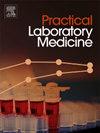孕期糖化白蛋白与体重指数呈负相关,并增加妊娠糖尿病的风险
IF 1.7
Q3 MEDICAL LABORATORY TECHNOLOGY
引用次数: 0
摘要
目的 我们的研究旨在确定妊娠 30 周糖化白蛋白(GA)的参考区间,研究 GA 是否可以取代或减少妊娠期口服葡萄糖耐量试验(OGTT),并重新评估体重指数(BMI)、年龄和空腹血糖在检测妊娠糖尿病(GDM)中的作用:我们测量了 486 名健康孕妇的妊娠期糖尿病。以结果的 95% 为中心计算参考区间。绘制了 ROC 曲线,分别评估 GA、空腹血糖和体重指数检测 GDM 的能力,并使用逻辑回归分析估算在相同指标水平下罹患 GDM 的风险。最后,基于 GA、空腹血糖和 BMI 的多重逻辑回归分析被用来寻找预测患者 GDM 风险的策略。该分析在检测 GDM 方面的 AUC 较低(0.53)。由于 GA 与体重指数成反比,因此在对体重指数进行校正后,AUC 略微上升至 0.64。将 GA 与空腹血糖和孕 16-20 周时的 BMI 相结合,可将 AUC 提高到 0.80。GA不能取代OGTT用于诊断GDM,也不能用于识别有患GDM风险的妇女。GA与孕早期空腹血糖和体重指数相结合,可作为估计GDM风险的有用模型。本文章由计算机程序翻译,如有差异,请以英文原文为准。
Glycated albumin in pregnancy correlates negatively with body mass index and contributes to the risk of gestational diabetes mellitus
Objectives
The aims of our study were to establish a reference interval for glycated albumin (GA) in gestational week 30, to investigate whether GA can replace or reduce the need for oral glucose tolerance test (OGTT) in pregnancy, and to reassess the usefulness of body mass-index (BMI), age and fasting glucose in detection of gestational diabetes (GDM).
Design
and methods: We measured GA in 486 healthy pregnant women. Reference interval was calculated using the central 95 % of the results. ROC curves were created to assess the ability of GA, fasting glucose and BMI separately to detect GDM, and logistic regression analysis was used to estimate risk of developing GDM given the level of the same markers. Finally, multiple logistic regression analysis based on GA, fasting glucose and BMI was used to find a strategy of predicting a patient's risk of GDM.
Results
The reference interval for GA at week 30 of gestation is 6.8–10.3 %. The analysis has a low AUC (0.53) with respect to detecting GDM. It increases slightly to 0.64 when corrected for BMI, as GA is inversely correlated to BMI. Combining GA with fasting glucose and BMI at gestational weeks 16–20 could raise the AUC to 0.80.
Conclusion
GA cannot be recommended to replace OGTT for the diagnosis of GDM. Nor can it be used to identify women at risk of developing GDM. GA combined with fasting glucose and BMI in early pregnancy could be a useful model to estimate risk of GDM.
求助全文
通过发布文献求助,成功后即可免费获取论文全文。
去求助
来源期刊

Practical Laboratory Medicine
Health Professions-Radiological and Ultrasound Technology
CiteScore
3.50
自引率
0.00%
发文量
40
审稿时长
7 weeks
期刊介绍:
Practical Laboratory Medicine is a high-quality, peer-reviewed, international open-access journal publishing original research, new methods and critical evaluations, case reports and short papers in the fields of clinical chemistry and laboratory medicine. The objective of the journal is to provide practical information of immediate relevance to workers in clinical laboratories. The primary scope of the journal covers clinical chemistry, hematology, molecular biology and genetics relevant to laboratory medicine, microbiology, immunology, therapeutic drug monitoring and toxicology, laboratory management and informatics. We welcome papers which describe critical evaluations of biomarkers and their role in the diagnosis and treatment of clinically significant disease, validation of commercial and in-house IVD methods, method comparisons, interference reports, the development of new reagents and reference materials, reference range studies and regulatory compliance reports. Manuscripts describing the development of new methods applicable to laboratory medicine (including point-of-care testing) are particularly encouraged, even if preliminary or small scale.
 求助内容:
求助内容: 应助结果提醒方式:
应助结果提醒方式:


